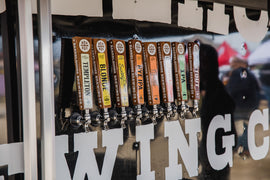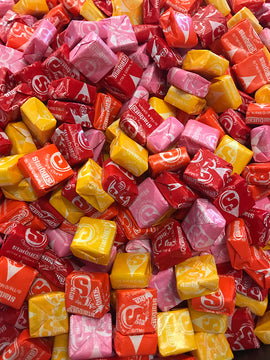Italian Wine Club ~ La Dolce Vite
Valle d’Aosta
October 2018
Tucked into the northwest corner lies the smallest Italian region, Valle d’Aosta located between the French and the Swiss Alps and Piemonte. Aosta is the capital and is also the only province. The region is bilingual and speaks mostly French as well as Italian, and is a member of the International Association of Francophone Regions.
Surrounded by the four tallest mountains of Italy (Monte Bianco, Cervino, Gran Paradiso and Monte Rosa) the region’s main economy is mountain tourism:skiing, rock climbing, and hiking bring visitors all year around. There are several amazing castles that dot the landscape, like Fénis and Issogne that pique the interest of travelers.
Valle d’Aosta is also the highest place in Europe where the vitis vinifera is cultivated.
The vineyards are planted on terraces that can reach up to 3600 ft. with inclination of 30%. Due to the specific structure of the territory, its moraine origin, there are different micro-climate zones - the common characteristics are warm summers, low precipitation and big temperature excursions between day and night. Another aspect is the presence of the Dora Baltea River that bisects the valley region from east to west creating two distinct sides: the left, called Adret is the one that receives more sun light and where the vines are cultivated; the right, called Enver, is less sunny and is dedicated to apple orchards, potatoes and cow pastures.
Valle d’Aosta is an unknown place to many Americans. My recommendation is to those who go to Italy and visit Piemonte to take some extra time and go north to see this beautiful place. Just the mountains are worth the effort, and don’t forget the cheeses and the wine…
Elio Longobardi, Italian Wine Specialist
PlumpJack Wine & Spirits – Noe Valley
Chateau Feuillet, 11010 St. Pierre, Valle d’Aosta
This time I chose just one producer for the two wines of this region. When I started to look for Valle d’Aosta wines it was not so easy to find them; the main reason is there aren’t so many producers that are imported into the American market. I’ve chosen Maurizio Fioroni because I like his wines and his story.
Maurizio grew up outside Turin and moved to Milan for his studies, but his life took an unexpected turn when he married and moved with his wife to her hometown of Saint Pierre in the Valle d’Aosta, where the family had an inn. He continued his work as a surveyor, but his long commute became burdensome when the two of them started a family. By the time their second child came along, Maurizio had had enough and left his old job for good. He didn’t have any definite plans but didn’t have any interest in joining his wife to run the inn. It’s good to be together, but working in the same place maybe was too much, this was Maurizio’s thinking. Luckily his wife had inherited vineyards from her family, so why not make wine to serve in her restaurant? The idea suited him perfectly, and he went to work in the vines. In the beginning his production was tiny: he signed up to show his first vintage at VinItaly but arrived at the gargantuan expo with just four bottles! Today his production remains small, about 1500 cases, but he has expanded the types of wine that he makes, from whites and reds to rose’ to sparkling, to late harvested.
If Maurizio became a vineyard owner by chance, he was exceedingly lucky in the placement of his plots—he will humbly tell you that it’s not hard to make good wine here. The vines sit in a very shallow sandy soil, but their feet wriggle into crevices in the solid granite bedrock. Cleansing winds quickly dry out any rain. The vineyards are planted on an ancient riverbed, where over the millennia the Dora Baltea River has cut through the mountain, creating the current river valley and leaving behind mineral deposits that the vines happily lap up. The most important aspect, however, is the exposition of the vineyards, which face south. In combination with the chilly climate, high altitude, and drastic diurnal temperature, these shifts provide the magic charm sought by vignerons everywhere: extremely long hours of gentle sunlight. In fact, the vineyards here capture the sun so perfectly that the almond trees scattered over the slope blossom at the same time as those in Sicily, over 550 miles farther south! This gives the grapes an exceptionally long, slow ripening season that in turn offers very unusual red wines with the heft of a sunny climate that are still refreshing and light on their feet, as you might expect of a northern wine.
Chateau Feuillet, Petite Arvine, Valle d’Aosta DOP 2017
Made by 100% Petite Arvine, a grape that grows only in Valois (Suisse) and Valle d’Aosta. The vines are an average of 10 years old, planted on sandy, alluvial topsoil on granite bedrock subsoil. Harvest is done in the mid of October. Fermentation and ageing in stainless steel tank.
The wine has a brilliant green/gold color. The sensory examination of this wine shows perfumes of flowers, citruses and mango, hints of anise and white pepper, fresh mouth, full body, minerals and very persistent.
Pairs well with veggie appetizers such fried pardon peppers, eggrolls, fried calamari or melted raclette cheese.
Chateau Feuillet, Fumin, Valle d’Aosta DOP 2017
In the 1960, famous viticulture experts tried to convince farmers of the region to get rid of Fumin arguing that this varietal was not apt to make quality wines; this campaign almost led to the disappearance of this grape. Luckily not every farmer listened to “the experts” and Fumin became not only one of the most distinguished Valle d’Aosta varietal, but also a high quality wine varietal.
Fumins resistance to cold also explains why we find this grape planted on the right bank of the Dora Baltea River, which is the colder side of the valley.
The wine in this bottle is made by 90% Fumin and 10% Syrah, from the same type of soil where Petite Arvine is grown. The harvest is done between end of October and the beginning November. The wine ferments for 15-20 days in stainless steel tanks; malolactic occurs in 300 liter French barrels where it also ages for 3-6 months before returning to steel tanks to mature before bottling in May.
The color is dark ruby with some purple reflections in the glass. The nose catches a whiff of freshly ground black pepper. Blackberry, forest floor and vinous notes for a long finish.
Wine to try with Middle Eastern and Mediterranean dishes like lamb shawarma, mouton couscous as well as polenta with wild mushroom sauce or Carbonade (see recipe below).
Carbonade
Carbonade is a traditional Valle d’Aosta recipe, originally from Belgium and then adopted by the area around the western Alps of Italy and the southwest of France.
A braised hearty dish for the cold season or after a day spent up in the mountains.
Ingredients (serves 4)
- 500g beef sirloin
- ½ Lt dry red wine (preferably from Valle d’Aosta)
- 1 small yellow onion and 1 medium yellow onion
- 2 cloves of garlic
- 1 stalk of celery
- 1 sprig of rosemary
- 1 sprig of sage
- 1 sprigs of parsley
- 2 tbsp. of flour
- 2 tbsp. of butter
- Salt & pepper
Directions:
- Cut the beef in cubes ½ inch size
- Marinade the beef with the wine (reserving ½ glass for later), small onion, garlic, celery, rosemary and sage 24 hours before or at least overnight
- The next day drain the marinade, vegetables and herbs from the beef
- Using a braising pan melt the butter over medium-low flames
- Let the butter start foaming but not brown
- Add the medium onion thinly sliced and cook until very soft
- Drench the meat in the flour and add to the pan
- Stir the meat in until get a nice golden color
- Add the ½ glass of wine and let evaporate
- Cook the beef on low heat with the lead slightly open for 2 hours or until the meat start to fall apart
- Serve over polenta or with mash potatoes
Valle d’Aosta proverb: Oeuf d'une heure, pain d'un jour, vin d'un an.
(Egg of the same hour, bread of the day, wine at least one year old. Basically the best of life!)





